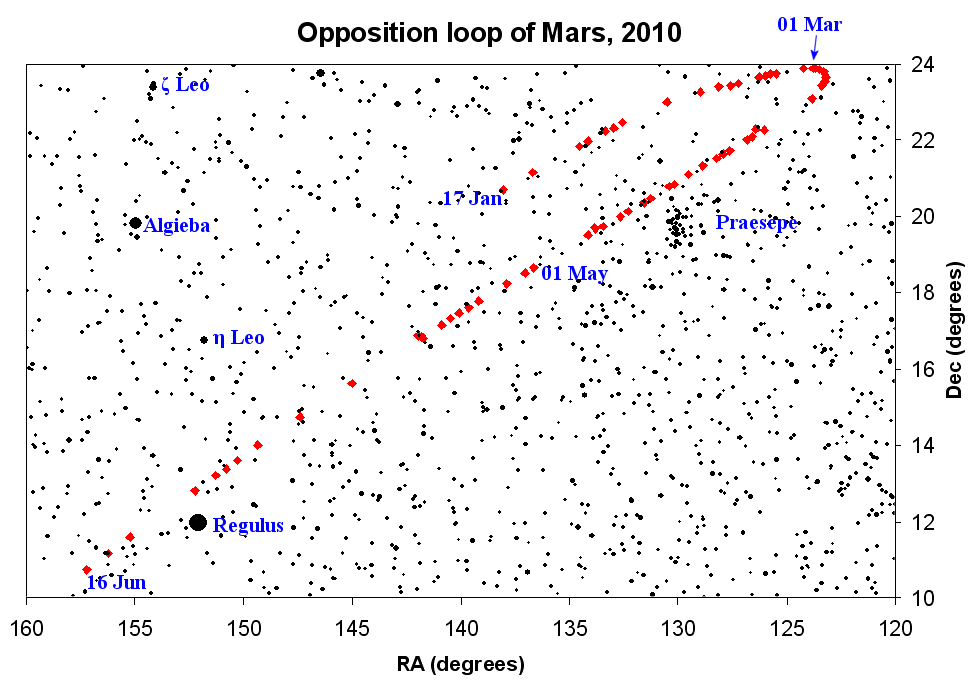
Orwell Astronomical Society (Ipswich)
Opposition Loop Of Mars, 2010
Here's an easy astronomy project that requires only a simple, inexpensive digital camera and a star atlas, yet produces very pleasing results!
It's well known that the noun planet comes from the Greek πλανητης meaning wanderer. A superior planet (orbiting at a greater distance from the Sun than the Earth) generally moves through the heavens prograde (in the direction of increasing RA). However, around the time of opposition, as the Earth in its orbit catches up with and overtakes the planet, the latter appears to become momentarily stationary, then move retrograde (in the direction of decreasing RA) for a period before again becoming momentarily stationary and then resuming prograde motion. As the orbits of the Earth and the superior planet are not coplanar, this results in the planet appearing to describe a loop in the sky.
Mars, being the closest of the superior planets to the Earth, displays the most pronounced opposition loop. The planet began the opposition loop of its 2009-10 apparition on 22 December 2009 and resumed prograde motion on 11 March 2010. In January 2010, once the planet became conveniently placed for evening observation, I began a project to photograph the remaining portion of its opposition loop. I used an inexpensive digital camera to photograph Mars against the background sky on every clear evening, starting on 17 January, and then analysed the images to estimate the coordinates of Mars and plot its motion against the background stars.
After a little experimentation, I adopted the following regime. Initially, Mars was bright enough to be seen in the camera viewfinder and I was therefore easily able to aim the camera. On each evening, I took four or five images with exposures in the range 2s - 16s, with the camera set to maximum aperture, maximum sensitivity (1600 ASA) and x5 optical zoom. The camera was mounted on a tripod, and the longer exposures resulted in appreciable trailing of the stars and planet. Generally, depending on the amount of haze in the sky, an exposure of 4s - 8s proved optimal: exposures of this length generally recorded stars to magnitude nine or so (considerably fainter on clear nights), yielded a good density of comparison stars close to the planet, resulted in a sky background of acceptable darkness and limited the length of trailing to an acceptable extent. In the later weeks of the project, once Mars was far from opposition and had become much fainter, it was not visible in the camera viewfinder and in order to locate it I had to take several images of circa 4s exposure, starting with a wide angle view and progressively increasing the magnification in two or three stages, after each adjusting the aim of the camera as necessary, before capturing the final images with x5 optical zoom.
I used the Paint Shop Pro graphics package to read the pixel coordinates of Mars and two nearby stars from each image, then consulted ESA's Hipparcos and Tycho electronic star catalogues to provide the coordinates of the stars, after which it only remained to use a spreadsheet to calculate the coordinates of Mars from those of the stars.
The chart below shows the results. Each red diamond represents one estimate of the position of Mars. The background stars are plotted from the Hipparcos and Tycho star catalogues, with magnitude indicated by size (larger dots represent brighter stars). At the time of the first positional estimate, 17 January 2010, Mars was in Cancer, already approximately one month into its opposition loop. Thereafter, Mars continued its retrograde motion, making its closest approach to the Earth at a distance of 99,330,000 km on 27 January and coming to opposition on 29 January. (At opposition, the planet shone prominently at magnitude -1.3, by far the brightest object in its region of the sky.) On 07 February, Mars passed 4° N of M44 (Praesepe). In early March, Mars' apparent motion slowed, and on 11 March it became momentarily stationary and then resumed prograde motion. Its speed then increased; on 15 April it passed just 2° N of M44 and on 12 May it passed from Cancer back into Leo, thereafter continuing its prograde motion.
The chart contains a few aberrant estimates that deviate from the otherwise smooth motion of the planet. The worst offender is the estimate on 03 April. On that evening, the sky was very hazy and only the brighter stars were visible. This forced me to use stars distant from the planet to estimate the position of the latter, and I believe that distortion in the edge field of the camera introduced inaccuracies in the positional estimate.
James Appleton